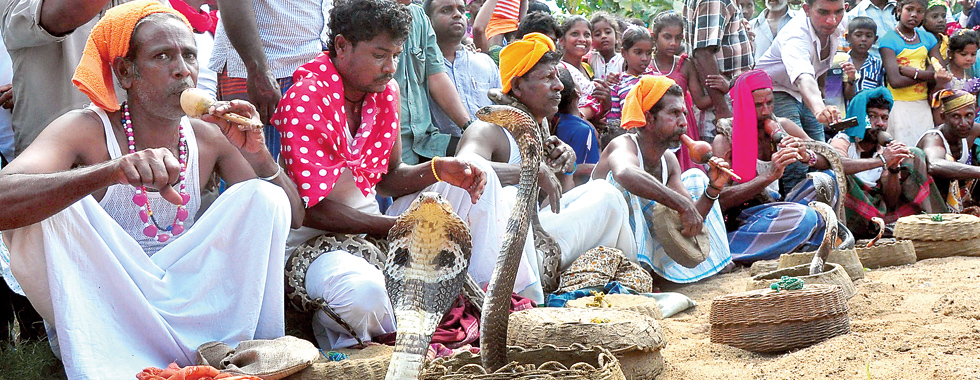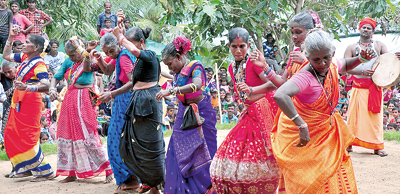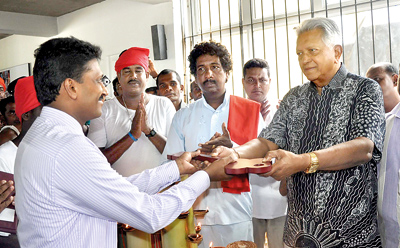Far from a charmed life
Cut-outs of smiling cobras hung on banana tree stumps line the road past Thambuttegama leading to the banks of the majestic Ranjangana Tank as it meanders along freshly-sown paddy fields. Suddenly out of the trees appear knots of elderly gypsies -bare torsos and blindingly bright sarongs tucked up, gunny sacks slung over their shoulders. They are carrying unmistakable woven baskets and we instinctively recoil, knowing of the cobras, and vipers that lie within.

Celebrating their culture: The snake charmers hold sway. Pix by Mangala Weerasekera
Curious glances soon turn into smiles warmer than the midday sun as they welcome us to the opening of the Sri Lankan Nomad Community Cultural Centre facilitated by Dilmah Conservation on November 16. Generally known as ahikuntakas, they now want to shake off that tag.
The centre not only opens up a new chapter of acceptance of the nomadic gypsy people in society, it will also serve as a reservoir of information of a community that is inevitably shedding their traditional livelihood and seeking new occupations in the city. Around 1000 gypsies from the five villages of Kudagama, Andarabedda, Kalawewa, Aligambe and Sirivalipuram attended the opening that morning in the hope of uniting as one people, and finding solutions to their troubles at the Variga Sabha (gathering and community court) with the leaders hearing complaints and resolving disputes that took place in the evening.
These Telengu gypsies, so-called because their origins are rooted in the Telengu speaking regions of Andhra Pradesh, India, make up a miniscule part of Sri Lanka’s population. No matter how small their numbers are, the vibrancy they add to Sri Lankan culture is vast, and it is our responsibility to protect this heritage, says Director, Dilmah Conservation Dilhan Fernando. “We came up with the idea of the centre in trying to address the social, economic and environmental issues of the Telengu nomadic community. They have a particular set of circumstances dictated by history and tradition and it is not practical to entirely phase out practices that are institutionalised into their tradition,” says Mr. Fernando, explaining that they face harsh criticism with their practices being seen as animal cruelty. Feasible mitigation methods are thus the need of the hour.
“While being sensitive to their culture, we will introduce entrepreneurship development projects in art and crafts that showcase their culture,” Mr. Fernando said adding that they hope that the centre would be a symbolic focal point for the Telengu gypsies, since they did not have a place to even host the Variga Sabha annually up until now.

A different beat: Gypsy women of all ages dance for the crowd
Built at a cost of Rs. 15 million, the cultural centre has a museum that holds the gypsies’ tools of trade- the woven snake-baskets (faavi fetta), snake-charming flutes (naserang), pitchers (labu-gedi) used to gather water and thatched tents. At the rear is an open theatre. Designed by the Faculty of Architecture of the University of Moratuwa, the Divisional Secretariat of Thambuttegama supervised the construction, with Dilmah Conservation providing the civil engineering and finances needed.
An explosion of colours invades the eyes as the gypsies begin their performance before the main event. The cobras slither out to the rhythm of the flutes, and the macaques dressed in little jackets show off their acrobatics.
The gypsies are a colourful community known for their snake-charming (pavunuarta), monkey-dancing (konti-arta) and palmistry (seisusav). Snake-charming takes prominence with its mystical attraction, while the women specialise in palm-reading. The communities also worship Hindu gods and deities, like Anagates Sami, Kannami Sami, Masamma, Sallapuramma, Pullayar and Paththini Amma, but today, many among them have converted to Buddhism and Christianity.
The village of Kudagama is home to 380 nomadic families, with around 2000 gypsies in total. The arachchi (leader) of Kudagama, R. Nadarajah, has seen the changes since the inception of the village in 1981 and as village leader since 1983 is liberal in his outlook, unafraid of embracing modernity.
His people are constantly on the move, setting camp in one city, showing off their snakes and reading palms, spending about 20 days away before returning home. But one cannot simply leave the village when money is short. The arachchi gives the orders, and sets a deadline of 20 days upon which they are supposed to return. If they fail to do so, they pay a fine.
Dancing takes prime importance in their lives, with the older women -dressed in colourful sarees and wearing long-beaded necklaces being enthusiastic performers. Alcoholism is rife amongst the community amongst both men and women.
Out of the thickets, a rasping voice is heard. Hamoma mey balanne, “All eyes on me,” cries an elderly gypsy with red-rimmed eyes. We watch, awe and horror mingled, as he pulls out a cobra and puts its head in his mouth, attempting a localised version of knife-swallowing.
Snake-charming is not all about the theatrics, we learn. “It’s not as easy as it looks,” says 32-year old Jamis Udayagiri. “We don’t consider the snake to be a source of evil as others would think. Snake charming is holy and should be done with respect,” he adds. Having learnt the tricks of the trade from the early age of 14, Udayagiri has caught more than 500 snakes to date. A snake can never be tamed, he says, and a gypsy would usually keep a snake for about a year before releasing it back into the wild.
As we speak, Udayagiri’s children turn up. Aged 4, 5, 13 and 14 they represent the younger generation of Telengu gypsies. Asked if he would teach them the secrets of the trade, Udayagiri smiles and tells us that he would do quite the opposite and encourage them to take up books instead of snake-baskets. “I have sent them to the Kudagama Maha Vidyalaya, and I want them to be well educated. Our way of life is not something you can live off in this century.”
S. Thimmana, 55, has a sluggish python wrapped around his neck as he speaks to us. Api okkoma kalawamey inne, he tells us that all religions and ethnicities have mingled together and there is no one true identity. If he had to pick, he would happily be known as a Sri Lankan. Like all the men, Thimmana too earns his livelihood through snake charming, and apart from his tattered vest and bright turban, his prized possessions are two cobras and a python. The cobras -de-fanged of course- are revered, while the gentle python is treated like a child. Usually a gypsy would only keep two cobras, a python, a viper and a macaque monkey with him, but a few capture more animals than needed.
On a good month, snake-charming would earn them around Rs. 10,000- 15,000. “This does not suffice for the month and therefore most in our community go looking for odd jobs. Some spend months away from the village doing work such as brick-laying or selling books on the bus,” says Thimmana.
At the opening ceremony where Dilmah founder, Merrill J. Fernando is also present, the gypsies perform an array of cultural items. A wedding scene is played out with the bride and groom being seated on a mol-gaha while the seniors dance, and shower the newly-weds with confetti made from aba, kurakkan and wee pora. The inimitable flute plays in the background, as the dowry is presented to the groom – a snake-basket, a flute and a hunting dog as the usual arsenal.

Giving a helping hand: Dilmah founder Merrill J. Fernando making a presentation to Thambuttegama Divisional Secretary J.W.S. Kithsiri, while village leader R. Nadarajah looks on
The snake-charmers take the stage next with a rare show of 35 cobras being charmed in unison. Later in the evening, as the moonlight spreads across the Rajangana, the kurumba lamps (empty kurumba shells filled with oil and flared using cloth) are lit shedding an uncanny light on the theatre arena that is to host the much awaited Variga Sabhawa. Once again, the drums are beating, the flutes are blowing and the older folk break into dance as they parade a white-clothed individual towards the brink of the reservoir. He is asked to kneel on the river bank and bathed with a kulla, before being paraded back in. “This man’s wife passed away recently and we are bathing him in the hope of warding away any evil spirits,” explains Nadarajah. Back at the centre, the oil in the kurumba gedi burns on as the leaders get ready for the gathering.
The five leaders: Nadarajah of Kudagama, Egatannage Masanna of Andarabedda, Anawattu Masanna of Kalawewa, M. Rasakumar of Aligambe and Karupan Silva of Sirivallipuram all take turns in thanking the “loku-mahaththaya” of Dilmah, Merrill J. Fernando for giving them the centre. The issue of fines is taken up next, and Nadarajah explains that a couple has been caught eloping. Tradition states that their tongues must be burnt, but here, betel leaves are placed in their mouths which are in turn burned with a gini-penella. Another punishment comes in the form of placing weights up-to 150 kilograms on the head of a woman charged with promiscuity.
Soon the discussion moves to the problems surrounding their community -the lack of proper drinking water in the village, their men taking up odd jobs away from the village for more than 20 days, and the fact that some of their animals have been captured by wildlife officials.
The traditional gathering, convened after 60 years on January 28, 2011 in Kudagama, facilitated by Dilmah Conservation on the evening of the foundation stone laying ceremony for the centre. The one we are witnessing is only the second Variga Sabha since the 1940’s adding to a heightened sense of enthusiasm on the part of the locals themselves, especially the children who have missed out on fundamental elements of their own culture.
As the kurumba lamps flicker and dim, the Variga Sabha draws to a close and the leaders read out their pledge of implementing decisions taken here. The gypsies disperse, pride in their eyes as they walk past the centre they can call their own, where their colourful identity that symbolizes the wealth of this tiny multi-cultural island can be preserved.



